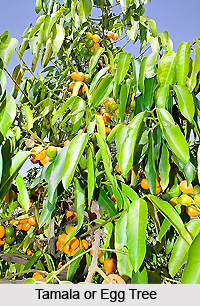 Tamala, the Indian medicinal plant is scientifically named as Garcinia xanthochymus Hook. f. & T. Anderson. This plant is commonly named as `Tamal` in Bengali, Hindi and Tamala in Sanskrit, `Egg tree` in English, `Karamala` in Gujarati , `Anavaya` in Malayalam and `Devagarige` in Kannada. The people of Goa call it by the name `Dharambe` , the people of Maharashtra specify the plant by the name of `Jharambi`. This same plant is recognised as `Cheoro` in Orissa and `Kulavi` in Tamil Nadu.
Tamala, the Indian medicinal plant is scientifically named as Garcinia xanthochymus Hook. f. & T. Anderson. This plant is commonly named as `Tamal` in Bengali, Hindi and Tamala in Sanskrit, `Egg tree` in English, `Karamala` in Gujarati , `Anavaya` in Malayalam and `Devagarige` in Kannada. The people of Goa call it by the name `Dharambe` , the people of Maharashtra specify the plant by the name of `Jharambi`. This same plant is recognised as `Cheoro` in Orissa and `Kulavi` in Tamil Nadu.
Tamala, the Indian medicinal plant is widely distributed on a variety of soil types up to 1200 metre elevation in the lower hill forests of the eastern Himalayas from Assam to Bihar. In Orissa, in the Western Ghats from Maharashtra southwards to Tamilnadu and Kerala and in the Andaman Islands, this plant is found in abundance.
The size of the Tamala, the Indian medicinal plant varies from medium to large. This is a bushy, evergreen tree, with a straight bole and angular spreading branches arising in tiers. The bark of the plant is dark and scabrous. The twigs are quadrangular. Leaves are large, coriaceous, shining and bright green in colour. The leaves are 20cm to 45cm long and 4cm to 10cm wide, linear oblong or oblong lanceolate, apex is acute or acuminate. The petioles are 1.2cm to 2.5cm long. Male flowers are white and borne in 4-8 flowered fascicles in the axils of fallen leaves. The pedicels are 2.5cm to 3.8cm long, sepals are five in number, fleshy, 4mm to 6mm long, unequal, orbicular, concave and persistent. There are five petals and they are orbicular, spreading and 8 mm in diameters. The flowers are hermaphrodite similar to those of the male but with longer pedicels. Fruits are smooth, globular, 5cm to 9cm in diameter, with a prominent beak and the fruits turn yellow when they get ripe. Each fruit contains 1 to 4 oblongseeds. The peak time of flowers is during the spring and fruits come out in summer.
Tamala , the Indian medicinal plant is recognised for the medicinal properties it owns. The fruit has a juicy pulp with a pleasant and acidic flavour. The fruit is used as a cooling drink to treat biliousness and as a substitute for the fruit of Garcinia indica. The fruit is also considered anthelmintic and cardiotonic, and useful for improving appetite. The seeds contain antiscorbutic oil that is a powerful and effective remedy for dysentery and diarrhoea.
The bark of Tamala is astringent and is useful for treatment of dysentery. The fruit functions as preservatives and in cookery it is used as a substitute for tamarind paste in curries.



















